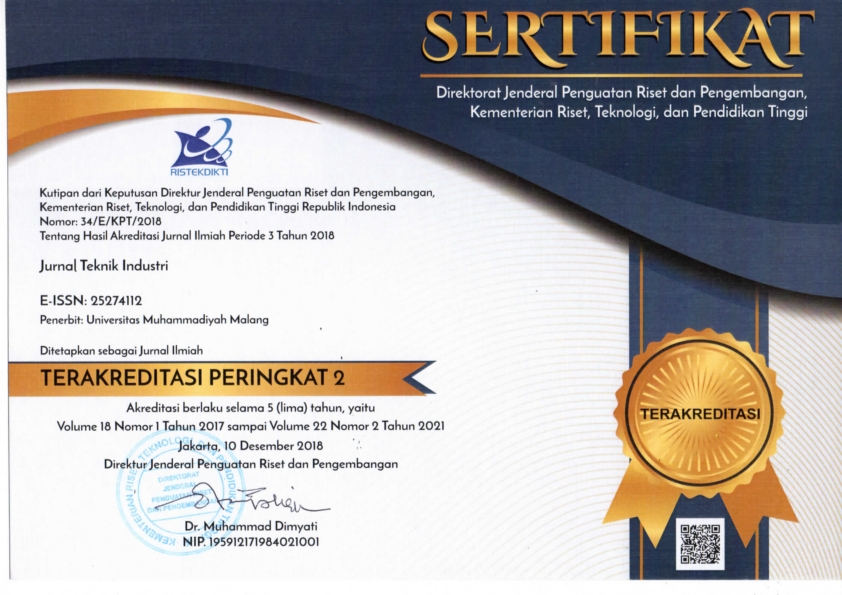Peningkatan Produktivitas Dan Kinerja Lingkungan Menggunakan Metode Green Productivity
DOI:
https://doi.org/10.22219/JTIUMM.Vol16.No2.63-73Keywords:
Green Productivity, Productivity, Environmental Performance, EPI, PG Kebon AgungAbstract
Every company certainly wants to increase their productivity, such as by increasing the amount of production. However, as goes by production, important to notice the aspects surrounding of the environment performance. Therefore we need a method to improve productivity and environmental performance simultaneously. The purpose of this study is to identify factors that affect the productivity and environmental performance, and provide suggestions using the method of Green Productivity improvements based on the highest value of Green Productivity Index. Based on research in PG Kebon Agung there are two alternative solutions that improve productivity and environmental performance, but the GPI of alternative 2 is bigger than ternative 1 which is 4,47. The alternative is additional outlet capacity at waste treatment plants. This solution provides increased productivity, where the initial productivity of 136.045% to 136.05%. With the implementation of alternative solutions can improve EPI index up 0.32 so to give an increase in the Index EPI (Environmental Performance Indicator) from 0.46 became 0.78Downloads
References
L. Yang, "A Study on the Difference of Heterogeneous Firms in Productivity, Production Scale and Production Technology," 2015.
R. Ortega-Argilés, M. Piva, and M. Vivarelli, "The productivity impact of R&D investment: are high-tech sectors still ahead?," Economics of Innovation and New Technology, vol. 24, pp. 204-222, 2015.
S. Chen and J. Golley, "‘Green’productivity growth in China's industrial economy," Energy Economics, vol. 44, pp. 89-98, 2014.
M. A. Darmawan, M. P. I. F. Putra, and B. Wiguna, "Value chain analysis for green productivity improvement in the natural rubber supply chain: a case study," Journal of Cleaner Production, vol. 85, pp. 201-211, 2014.
W. Rusiawan, P. Tjiptoherijanto, E. Suganda, and L. Darmajanti, "Assessment of green total factor productivity impact on sustainable Indonesia productivity growth," Procedia Environmental Sciences, vol. 28, pp. 493-501, 2015.
S.-J. Shin, S.-H. Suh, and I. Stroud, "A green productivity based process planning system for a machining process," International Journal of Production Research, vol. 53, pp. 5085-5105, 2015.
K. WANG, X. MENG, L. YANG, and Y. CHENG, "Heterogeneous Production Technology and Regional Green Total-factor Productivity Growth——An Analysis based on Meta-frontier and China's Provincial Panel Data of 2000—2012," Journal of Beijing Institute of Technology (Social Sciences Edition), vol. 1, p. 004, 2015.
M. Leng and M. C. Ibarra-Vidal, "The Green Solution: Optimizing productivity of bi-substrate microalgae cultures," 2015.
L. Vetter, G. Schuepfer, S. P. Kuster, and M. Rossi, "A Hospital-wide Outbreak of Serratia marcescens, and Ishikawa's “Fishbone” Analysis to Support Outbreak Control," Quality management in health care, vol. 25, p. 1, 2016.
M. Jackson, "Concepts of Productivity," 2015.











